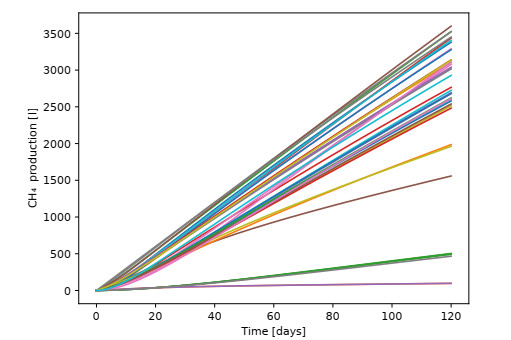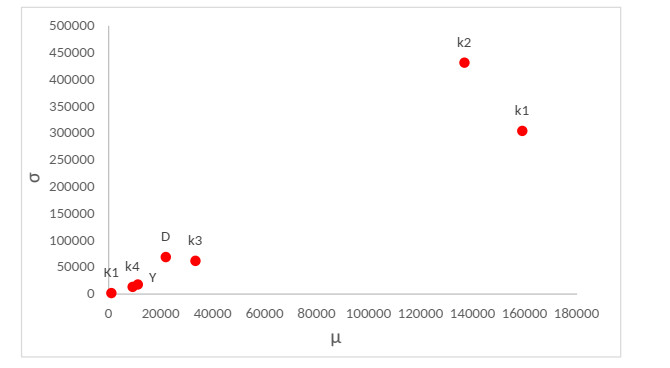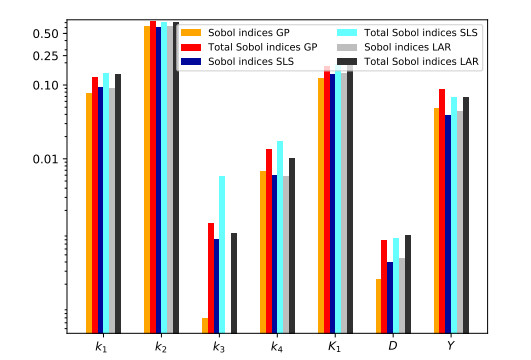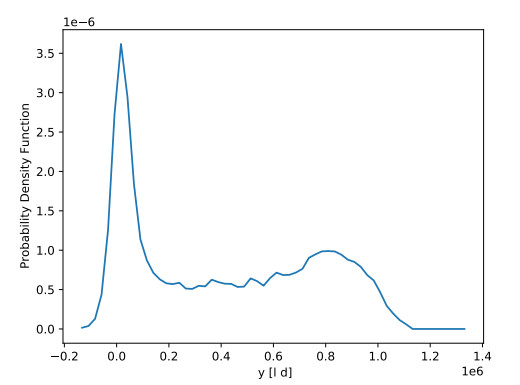1.
Introduction
Clarke's subdifferential operator is associated with a type of nonlinear inclusion known as hemivariational inequalities. These inequalities have applications in structural analysis and non-convex optimization. The two main types of inequality problems are variational inequalities and hemivariational inequalities. Hemivariational inequalities handle nonsmooth, nonconvex energy functions, whereas variational inequalities primarily deal with convex energy functions. In 1981, Panagiotopoulos introduced the concept of hemivariational inequality as a method to represent mechanical obstacles. Hemivariational inequalities or subdifferential inclusions can be used to model various nonsmooth contact mechanics issues involving multivalued and nonmonotone constitutive laws with boundary conditions (see [1,2,3]). Since then, numerous researchers have made significant contributions to the field of hemivariational inequalities, as seen in [4,5,6,7,8,9]. Moreover, neutral differential systems with impulsive effects have become a prominent area of research, modeling real-world processes that undergo sudden changes at specific points. This field has far-reaching applications in areas like finance, economics, mechanics, neural networks, electronics, and telecommunications. Notably, the authors of [10] investigated the controllability of nonlocal neutral differential inclusions with impulse effects. Researchers looked at the existence of impulsive multivalued neutral functional differential inclusions [11,12].
Research on controllability in hemivariational-type systems has gained significant attention from the scientific community in recent times. Control problems have significant implications for various fields, including engineering, physics, and finance [13]. Despite the progress made, many intriguing questions and concepts remain unexplored. Notably, the authors of [14,15] established the existence of optimal control in hemivariational inequalities, while [16,17] investigated optimal control in parabolic hemivariational inequalities. Furthermore, [18,19] demonstrated the existence of optimal control in hyperbolic systems, contributing to the advancement of the field. Due to their wide application to numerous pragmatist mathematics fields, neutral systems have attracted attention recently. Neutral systems have numerous applications in various fields, including thermal expansion of materials, biological advancements, surface waves, and stretchability, which benefit from neutral systems either directly or indirectly. Additionally, researchers have extensively studied hemivariational inequalities with a neutral type in [20,21]. For further information regarding the system with hemivariational inequalities, refer to [22,23,24,25,26]. Recently, there has been a surge of interest in Clarke's subdifferential evolution inclusion problems, particularly in the context of nonsmooth analysis and optimization. Frictional contact analysis can effectively characterize the interaction between a piezoelectric body and an electrically conducting foundation, and the frictional contact between a piezoelectric cylinder and a foundation exhibits anti-plane shear deformations. Moreover, the authors of [27] have established approximate controllability results for Sobolev-type Hilfer fractional neutral evolution problems with Clarke's subdifferential-type problems. Our proposed problem presents a model that combines the key elements of hemivariational inequality and fractional impulsive differential equations into a unified framework. This study establishes approximate controllability results for a neutral differential system with impulsive effects, formulated as a hemivariational inequality. Next, we will define the specific system under consideration, which will be the focus of our investigation:
Here ⟨⋅,⋅⟩M stands for the inner product of the separable Hilbert space M and A:D(A)⊆M→M is a closed, linear, and densely defined operator on M. H∘(φ,⋅;⋅) denotes the generalized Clarke's directional derivative [6] of a locally Lipschitz function H(φ,⋅):M→R. The function g1:L×M→M. The control function v∈V takes values from L2(L,V) and V is the control set which is also a Hilbert space. Let B:V→M be the bounded linear operator. Let 0<φ1<φ2<...<φm<φm+1=a be pre-fixed points and the symbol Δu(φi) represents the jump in the state u at time t which is defined by Δu(φi)=u(φ+i)−u(φ−i), and u(φ−i) and u(φ+i) denote the left and right limit of u at φi. Li:M→M and Ki:M→M,i=1,2,3,...,m, are impulsive functions.
The structure of the article is presented in the following way:
● We begin by reviewing key definitions, fundamental theorems, and initial findings from a previous section.
● The core focus then shifts to exploring the existence of mild solutions for the system represented by Eq (1.1).
● Next, we investigate the approximate controllability of the system (1.1).
● Finally, we solidify our theoretical results by presenting a concrete example.
2.
Foundations and background
Let Z and Z∗ be a Banach space and its dual, respectively with ‖⋅‖Z and ⟨⋅,⋅⟩ is the duality pairing of Z and Z∗. The Banach space PC(L,Z) is the set of all piecewise continuous functions from L=[0,a] into Z together with ‖u‖PC=supφ∈L‖u(φ)‖Z. Also,
Consider the non-autonomous second-order initial value problem:
where A(φ):D(A(φ))⊆M→M, φ∈[0,a] is a closed densely defined operator and f:[0,a]→M is an appropriate function. One can refer to [15,28,29,30] and the references therein. A significant number of articles relate the existence of solutions to the (2.1)-(2.2) problem to the existence of the evolution operator Q(φ,z) for the homogeneous equation
Assume that the domain of A(φ) is a subspace D that is dense in M and independent of φ, and that the function φ↦A(φ)z is continuous for each z∈D(A(φ)).
In view of Kozak's work [31], we shall apply the following evolution operator notion in this study.
Definition 2.1. A family Q of bounded linear operators Q(φ,z):[0,a]×[0,a]→L(M) is called an evolution operator for (2.3) if the following conditions are satisfied:
(Z1) For each z∈M, the mapping [0,a]×[0,a]∋(φ,z)→Q(φ,z)z∈M is of class C1 and
(i) for each φ∈[0,a], Q(φ,φ)=0,
(ii) for all φ,z∈[0,a], and for each z∈M,
(Z2) For all φ,z∈[0,a], if z∈D(A), then Q(φ,z)z∈D(A), the mapping [0,a]×[0,a]∋(φ,z)→Q(φ,z)z∈M is of class C2 and
(i) ∂2∂φ2Q(φ,z)z=A(φ)Q(φ,z)z,
(ii) ∂2∂z2Q(φ,z)z=Q(φ,z)B(z)z,
(iii) ∂∂z∂∂φQ(φ,z)z|φ=z=0.
(Z3) For all φ,z∈[0,a], if z∈D(A), and then ∂∂zQ(φ,z)z∈D(A), then ∂2∂φ2∂∂zQ(φ,z)z, ∂2∂z2∂∂φQ(φ,z)z, and
(i) ∂2∂φ2∂∂zQ(φ,z)z=A(φ)∂∂zQ(φ,z)z,
(ii) ∂2∂z2∂∂φQ(φ,z)z=∂∂φQ(φ,z)A(z)z,
and the mapping [0,a]×[0,a]∋(φ,z)→A(φ)∂∂zQ(φ,z)z is continuous.
Let us take
Also, for some positive constants N1 and N2, we set sup0≤φ,z≤a‖Q(φ,z)‖≤N2 and sup0≤φ,z≤a‖C(φ,z)‖≤N1 and
for all z,φ,φ+g∈[0,a]. The mild solution z:[0,a]→M of (2.1)-(2.2) is:
Let us start by discussing the necessary definitions and findings from the multivalued analysis. The following sources [7,32,33] are recommended for readers in addition to multivalued maps.
Definition 2.2. Given a Banach space Z and a multivalued map H:Z→2Z∖{∅}=N(Z), we say
(i) H is convex and closed valued, only when H(u) is convex and closed valued for all u∈Z.
(ii) H is said to be upper semicontinuous on Z, if for all y∈Z, H(u)≠∅ is closed in Z and if for each open set J1 of Z which contains H(u), then there is an open neighborhood E of u such that H(E)⊆J1.
(iii) H is bounded on bounded sets if H(B)=∪u∈BH(u) is bounded in Z for all B∈Mb(Z) (i.e., supu∈B{sup{‖k‖:k∈H(u)}}<∞).
(iv) H is supposed to be completely continuous provided that H(J1) is relatively compact, for all bounded subset J1⊆Z.
(v) H has a fixed point if there is a u∈Z such that u∈H(u).
For a locally Lipschitzian functional H:Z→R, we denote H0(q;p), the Clarke's generalized directional derivative of H at point q in the direction of p, that is,
Also, ∂H(q):={q∗∈Z∗:H0(q;p)≥⟨q∗;p⟩,for every p∈Z} denotes the generalized Clarke's subdifferential.
The subsequent features and outcomes will facilitate our goal achievement:
Lemma 2.3. [9] If the function H:℧→R is a locally Lipschitz on an open set ℧ of Z, then
(i) For all p∈Z, it has H0(q;p)=max{⟨q∗;p⟩: for all q∗∈∂H(q)};
(ii) For all q∈℧, the gradient ∂H(q) is a nonempty, convex, weak∗-compact subset of Z∗ and ‖q∗‖Z∗≤M, for all q∗∈∂H(q);
(iii) The graph of ∂H is closed in ℧×Z∗ℓ∗. That is, if {qn}⊂℧, {q∗n}⊂Z∗ are sequences as q∗n∈∂H(qn) and qn→q∈Z, q∗n→q∗ weakly∗ in Z∗, then q∗∈∂H(q) (where the Banach space Z∗ furnished with the ℓ∗-topology is denoted by Z∗ℓ∗);
(iv) The multifunction ℧∋q→∂H(q)⊆Z∗ is upper semicontinuous which maps ℧ into Z∗ℓ∗.
Lemma 2.4. [9] Let Z be the separable reflexive Banach space, 0<a<∞ and H:(0,a)×Z→R, such that H(⋅,w) is measurable for each w∈Z and H(φ,⋅) is locally Lipschitz on Z for all φ∈(0,a). Then the multifunction (0,a)×Z∋(φ,w)↦∂H(φ,w)⊂Z∗ is measurable.
As discussed in [9], we can investigate the existence of mild solutions and approximate controllability for the following semilinear inclusions:
Now, we can explore the implication that every solution to Eq (2.5) is also a solution to Eq (1.1). Hence, if u∈PC(L,M) is a solution of (2.5), there exists h(φ)∈∂H(φ,u(φ)) provided h∈L2(L,M) and
which implies
Since ⟨h(φ),ω⟩M≤H0(φ,u(φ);ω) and h(φ)∈∂H(φ,u(φ)),
Therefore, our initial focus will be on examining the semilinear inclusion (2.5), which proceeds our investigation of the hemivariational inequality (1.1). According to established literature [33,34], the mild solution for problem (2.5) is defined as below.
Definition 2.5. For all v∈L2(L,V), a function u∈PC(L,M) is a mild solution for (2.5) if there exists h∈L2(L,M) as h(φ)∈∂H(φ,u(φ)) almost everywhere on φ∈L,
Let us take the following assumptions:
(A1) The function H:L×M→R satisfies:
(i) ∀ u∈M, φ↦H(φ,z) is measurable;
(ii) u↦H(φ,u) is locally Lipschitz continuous for a.e. φ∈L;
(iii) There is a function b(φ)∈L2(L,R+) and e>0 such that
(A2) In the function g1:L×M→M, there exists some constants C1,C2>0, and for every u∈M, φ1,φ2∈L, we have
(A3) For some constants ci,li>0, the maps Li,Ki:M→M are continuous, and
Let M:L2(L,M)→2L2(L,M) be defined as below:
Lemma 2.6. [35] Let (A1) and M be true. If un→u in L2(L,M), wn→w weakly in L2(L,M) and un∈M(un), and then u∈M(u).
Lemma 2.7. [9] Let all hypotheses and (A1) hold. Then for every u∈L2(L,M), the set M(u) has nonempty, weakly compact and convex values.
Theorem 2.8. [9] Consider the Banach space Z which is locally convex and Υ:Z→2Z is a compact convex valued, upper semicontinuous multivalued map such that there exists a closed neighborhood J of 0 for which Υ(J) is relatively compact provided
is bounded. Then Υ has a fixed point.
3.
Existence results
Theorem 3.1. For all v∈L2(L,V), provided that (A1)–(A3) are fulfilled, then (2.5) has a mild solution on L such that a(N1C2+N2e)<1, where N1:=supφ,z∈[0,a]‖C(φ,z)‖, N2:=supφ,z∈[0,a]‖Q(φ,z)‖.
Proof. Initially, choose any u∈PC(L,M)⊂L2(L,M), by Lemma 2.7. Now, define Υ:PC(L,M)→2PC(L,M) as:
It is clear that we can determine a fixed point of the multivalued map Υ that satisfies Theorem 2.8. First, note that the set-valued map Υ(u) is convex due to the properties of M(u). Now, let us proceed with the proof of the theorem as follows:
Step 1. Υ(Br)⊆(Br),r>0, is bounded in PC(L,M), where Br={u∈PC(L,M):‖u‖PC≤r}. Here, it suffices to demonstrate the existence of a positive constant ℓ such that for each σ∈Υ(u), u∈Br,‖σ‖PC≤ℓ. If σ∈Υ(u), then there is a h∈M(u) provided
By Hölder's inequality,
Thus, Υ(Br) is bounded.
Step 2. {Υ(u):u∈Br} is completely continuous.
Let us note that for any u∈Br, σ∈Υ(u), there exists h∈M(u) such that for all φ∈L,
For 0<ξ1<ξ2≤a and k>0 very small,
From the uniform operator topology [33, Lemma 6.2], it is easily understood that (3.1) tends to zero of u∈Br as ξ2→ξ1 and k→0.
Equivalently, for ξ1=0 and 0<ξ2≤a, we can show that ‖σ(ξ2)−u0‖M tends to zero independently of u∈Br as ξ2→0. Hence, we can conclude that {Υ(u):u∈Br} is equicontinuous of PC(L,M).
Finally, from the assumptions (A1) and (A3) and by the definition of a relatively compact set, it is not difficult to check that {σ(t):σ∈Υ(Br)} is relatively compact in M. Thus, by the generalized Arzelˊa-Ascoli theorem, we get that Υ is a multivalued compact map.
Therefore, based on the above arguments, Υ is completely continuous.
Step 3. Assume un→u∗ in PC(L,M), σn∈Υ(un) and σn→σ∗ in PC(L,M). Let us check σ∗∈Υ(u∗). It is obvious that σn∈Υ(un) exist only when hn∈M(un) such that
Here {hn}n≥1⊆L2(L,M) is bounded from the hypothesis (A2). Hence we may assume that
From (3.2) and (3.3), we have
We can see that σn→σ∗ in PC(L,M) and hn∈M(u). According to Lemma 2.6 and (3.4), h∗∈M(u∗). Then, σ∗∈Υ(u∗), and this shows that Υ has a closed graph. Hence using Proposition 3.12 of [36] implies that it is upper semicontinuous.
Step 4. A priori estimate.
Based on the results from Steps 1–3, we have established that the multivalued map Υ satisfies the following properties: upper semicontinuity, convex-valuedness, compactness, and relative compactness of Υ(Br). Therefore, Υ meets the conditions of Theorem 2.8, which implies that
is bounded. To prove Υ has a fixed point, let u∈℧, and h∈M(u) such that
From our assumptions,
where
Hence, by the assumption K1<1 and (3.5), we can see that
Hence, Υ has a fixed point. □
4.
Approximate controllability results
Consider that the mild solution for the Eq (2.5) is u(⋅;v), the control variable v has values in L2(L,V), and the initial value is u0,u1∈M. At the terminal time a, the accessible set of the system (2.5) is defined as R(a,u0,u1)={u(a;u0,u1):v∈L2(L,V)}.
Definition 4.1. The Eq (2.5) is approximately controllable on L, if for any initial value u0,u1∈M, then ¯R(a,u0,u1)=M.
Consider the linear differential system:
Now, define the operators for the system (4.1) as:
where B∗ and Q∗(φ) are adjoint of B and Q(φ), respectively.
Lemma 4.2. [9] The system (4.1) is approximately controllable on L iff β R(β,Υa0)→0 as β→0+ in the strong operator topology.
Choose any β>0, u∈PC(L,M)⊂L2(L,M) and ua∈M, as stated in Lemma 2.7, and it is possible to define a multivalued map Υβ:PC(L,M)→2PC(L,M) given by
and
Theorem 4.3. Let (A1)–(A3) be true. Υβ, for all β>0, has a fixed point on L=[0,a] if
where N1:=supφ,z∈[0,a]‖C(φ,z)‖, N2:=supφ,z∈[0,a]‖Q(φ,z)‖.
Proof. For every u∈PC(L,M), by the nature of M(u), we can say Υβ is convex.
Step 1. For every p>0,Υβ(Bp) is bounded in PC(L,M),
Here, it is sufficient to prove that there exists a positive constant lβ and for all σ∈Υβ(u), u∈Bp, ‖σ‖PC≤lβ. If σ∈Υβ(u), there is h∈M(u) such that
Notice that
From (4.2),
Thus Υβ(Bp) is bounded in PC(L,M).
Step 2. Consider any u∈Bp, σ∈Υβ(u). There exists h∈M(u), for every φ∈L,
Using ‖vβ(t)‖ as (4.2) and also from Theorem 3.1, Step 2, one can obtain that {Υβ(u):u∈Bp} is completely continuous.
Step 3. Consider un→u∗ in PC(L,M), σn∈Υβ(un) and σn→σ∗ in PC(L,M). We investigate σ∗∈Υβ(u∗). Indeed, σn∈Υβ(un) exists only when hn∈M(un) such that
From (A1), we will prove {hn}n≥1⊆L2(L,M) is bounded. Hence,
From (4.3) and (4.4),
Clearly, σn→σ∗ in PC(L,M) and hn∈M(un). According to Lemma 2.6 and (4.5), h∗∈M(u∗). Then, σ∗∈Υ(u∗), and this shows that Υ has a closed graph. Hence, by using Proposition 3.12 of [36] implies that it is upper semicontinuous.
Step 4. A priori estimate.
By Steps 1–3, Υβ is convex valued, compact upper semicontinuous, Υβ(Bp) is a relatively compact set and meets Theorem 2.8, and
is bounded.
Consider u∈J. Then there exists h∈M(u) such that
and
Then from our assumptions,
where
According to K2<1 and (4.6), we conclude,
Therefore J is bounded which leads to the conclusion that Υβ has a fixed point. □
Theorem 4.4. Suppose the conditions of the above theorem are satisfied. Then, if system (4.1) is approximately controllable on the set L, it follows that system (2.5) is also approximately controllable on L.
Proof. By Theorem 4.3, Υβ, for all β>0, has a fixed point in PC(L,M). Let uβ be a fixed point of Υβ in PC(L,M). Clearly, Υβ is a mild solution of (2.5). Then, there exists hβ∈M(uβ) such that for each φ∈L,
Since I−Υa0R(β,Υa0)=βR(β,Υa0), we have uβ(a)=ua−βR(β,Υa0)E(hβ). From the above,
From the hypothesis (A1) and from Theorem 4.3, ‖∂H(φ,u)‖≤b(φ)+e‖u(φ)‖≤b(φ)+ep:=ν(φ). Then,
Consequently {hβ} is a bounded sequence in L2(L,M). So, there exists a subsequence, {hβ}, which will converge weakly to h in L2(L,M). It is expressed as
Now,
From Step 2 in Theorem 4.3 and by the Arzelˊa-Ascoli theorem, we get that the compactness of the right-hand side of (4.7) tends to zero as β→0+, which gives
Hence, (2.5) is approximately controllable on L. □
5.
Applications
We utilize our theoretical findings on a concrete partial differential equation. We need to provide the required technological resources to accomplish our goals.
Now, let us take
where A is the infinitesimal generator of a cosine function C(φ) with associated sine function Q(t), and ˜A(φ):D(˜A(φ))→M is a closed linear operator with D⊂D(˜A(φ)), for all φ∈L. We take the space M=L2(T,C), where the group T is defined as the quotient R/2πZ, and we denote by L2(T,C) the space of 2π periodic 2-integrable functions from R to C. Also, we use the identification between functions on T and 2π periodic functions on R. Furthermore, H2(T,C) denotes the Sobolev space of 2π periodic from R to C such that u′′∈L2(T,C).
We define Au(φ)=u′′(φ) with domain D(A)=H2(T,C). Then, A can be written as
where xn(φ)=1√2πeinφ(n∈Z) is an orthonormal basis of M. It is well known that A is the infinitesimal generator of a strongly continuous cosine function C(φ) on M. The cosine function C(φ) is given by
The connected sine operator (Q(φ))φ∈R is
It is clear that ‖C(φ)‖≤1 for all φ∈R, so it is uniformly bounded on R.
Assume the following second-order non-autonomous neutral differential system of the form:
where B:R→R is a continuous function such that supφ∈[0,a]‖B(φ)‖=c0, and u(φ,℘) represents the temperature at ℘∈(0,π) and φ∈(0,a). Let ϕ(φ,u(φ,℘))=ϕ1(ξ1,φ(φ,℘))+ϕ2(φ,u(φ,℘)) and ϕ2(φ,u(φ,℘)) is the temperature function of the form −ϕ2(φ,u(φ,℘))∈∂H(φ,℘,u(φ,℘)),(φ,℘)∈(0,a)×(0,π). Here, the nonsmooth and nonconvex function H=H(φ,℘,k) is defined as a locally Lipschitz energy function. ∂H is the generalized Clarke's gradient in the third variable k [6]. Assume that H fulfills the assumptions (A1), H(k)=min{h1(ν),h2(ν)}, and hi=R→R(i=1,2) are convex quadratic functions [16].
Now we take ˜A(φ)u(℘)=B(φ)u(℘) defined on H1(T,C). It is easy to see that A(φ)=A+˜A(φ) is a closed linear operator. Initially, we will show that A+˜A(φ) generates an evolution operator. It is well known that the solution of the scalar initial value problem
is given by
Therefore, the solution of the scalar initial value problem
satisfies the following equation:
By the Gronwall-Bellman lemma, we obtain
for z≤φ and c is a constant. We denote by pn(φ,z) the solution of (5.2)-(5.3). We define
It follows from the estimate (5.4) that Q(φ,z):M→M is well defined and satisfies the condition of Definition 2.1. We set u(t)=u(φ,⋅), that is, u(φ)(℘)=u(φ,℘), φ∈L, ℘∈[0,π]. Then, we assume the infinite dimensional Hilbert space V, and we have
with V as
Let us define B∈L(V,M) as below:
It continuous that
Assume these functions satisfy the requirements of the hypotheses. From the above choices of the functions and evolution operator A(φ) with B, system (5.1) can be formulated as system (2.5) in M. Since all hypotheses of Theorem 4.4 are satisfied, the approximate controllability of system (5.1) on L follows from Theorem 4.4.
6.
Conclusions
The principles of approximate controllability of second-order differential impulsive systems with the impact of hemivariational inequalities are the main focus of this article. The generalized Clarke's subdifferential technique and multivalued maps were used to suggest and demonstrate the necessary requirements for existence and approximate controllability. In the future, we will extend the results with finite delay and stochastic systems.
Author contributions
Yong-Ki Ma: Conceptualization, Methodology, Validation, Visualization, Writing–original draft. N. Valliammal: Conceptualization, Formal analysis, Methodology, Validation, Visualization, Writing–original draft. K. Jothimani: Conceptualization, Formal analysis, Investigation, Resources, Supervision, Writing–original draft. V. Vijayakumar: Conceptualization, Formal analysis, Resources, Supervision, Writing–original draft, Writing–Review & Editing. All authors have read and approved the final version of the manuscript for publication.
Acknowledgments
This work was supported by the research grant of Kongju National University in 2024. The authors are immensely grateful to the anonymous referees for their careful reading of this paper and helpful comments, which have been very useful for improving the quality of this paper.
Conflict of interest
The authors declare that they have no known competing financial interests or personal relationships that could have appeared to influence the work reported in this paper.



















 DownLoad:
DownLoad: